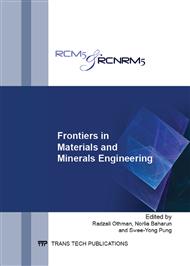p.137
p.141
p.147
p.151
p.159
p.164
p.171
p.177
p.184
Synthesis In Situ Composite TiAl-Based with Particulate Al2O3 Reinforcement by Powder Metallurgy Route
Abstract:
A major effort has been made over last 20 or so years to introduce TiAl-based alloys into the market-place as engineering component. Recently, titanium aluminide based composites are competitive candidate for aerospace use due to the favorable properties of matrix material, such as low density, high specific strength and relative good properties at elevate temperature [1-4]. The amount of aluminum in titanium alloys exceeds that used in conventional alloys and can range from 10 to 48at%. This concentration of aluminum allows the formation of an in-situ alumina reinforcement which is responsible for the excellent oxidation, sulfidation and carburization resistance at temperatures of 1000°C and higher. However, their brittleness and rapid crack growth rate at low to intermediate temperature hinders their application/3/. Nevertheless, nanostructure of monolithic TiAl is unstable at elevate temperatures which deteriorate the high temperature properties. In order to improve the high temperature strength of intermetallic, ceramic particles can be utilized as reinforcements [4, 5]. Recently, in-situ techniques have been utilized to fabricate TiAl-Al2O3 composite through displacement reaction between TiO2 and Al in planetary ball milling and subsequence heat treatment. The knowledge of reaction characteristic in the Al-TiO2 system is great importance to optimize the processing/4, 6/. The chemical compatibility with the iron aluminide matrix at temperature above 1000°C is an important factor for the selection of reinforcements because extreme interfacial reaction during processing results in the degradation of mechanical properties [3, 4].
Info:
Periodical:
Pages:
159-163
Citation:
Online since:
November 2013
Authors:
Keywords:
Price:
Сopyright:
© 2014 Trans Tech Publications Ltd. All Rights Reserved
Share:
Citation:


